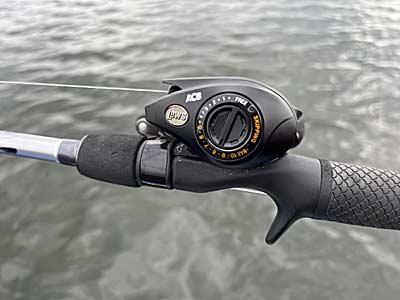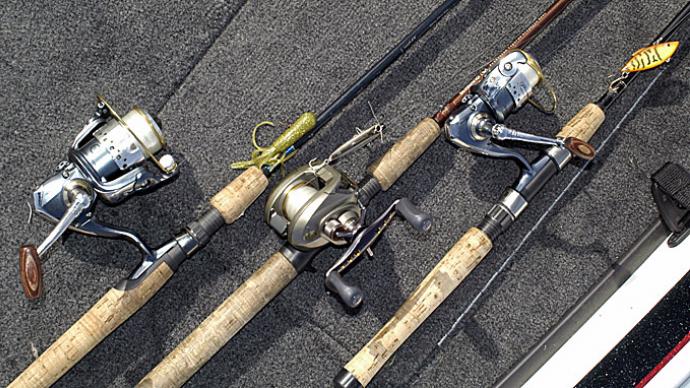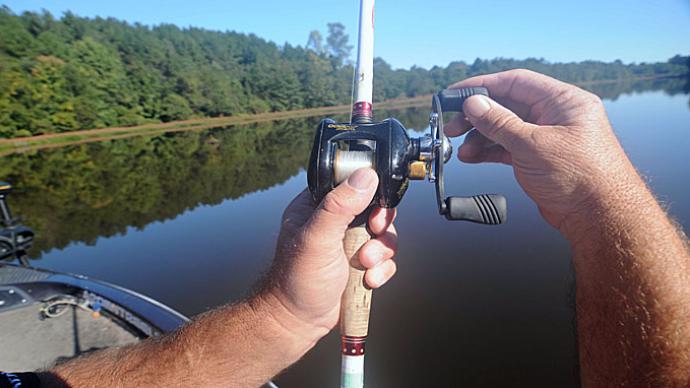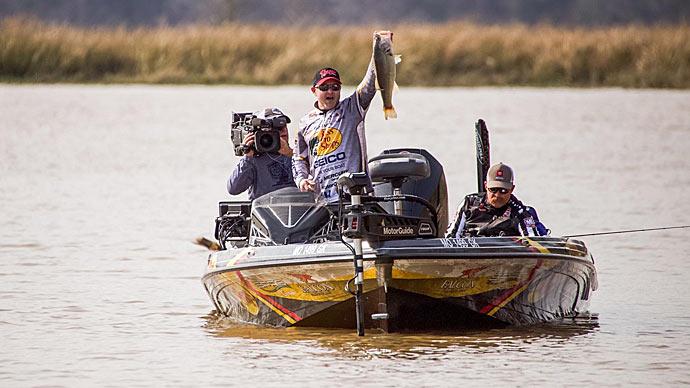

Bass anglers have an ever-increasing array of advanced technology to apply to pursue their sport. Fishing reels are no exception. Each year they become better designed and constructed out of new materials, often making them stronger, lighter, and more functional than their predecessors. As a result, even lower-priced reels are light years ahead of reels from just a decade ago.
These significant improvements in spinning and casting reels include better and more reliable drag systems and better quality components, including internal gears, drive assembly, and bearings.
| For more information: |
Using Baitcast Reels
Many low-profile baitcasting reels contain anti-backlash devices, including magnets and braking systems that make life easier for the beginner, starting a few decades ago when the old round baitcast reels were the standard for bass anglers.
The art of "thumbing" your spool is still important, but the braking systems can be dialed to where it is almost impossible to backlash some reels. Maximizing these tools will prevent some backlashes but can hurt your casting distance, so spool control is still an important thing to learn.
After all, the free spool on the baitcasting reel is just that, a wheel that turns as fast as the speed, or RPMs, induced by the weight of the line moving out. Without magnet systems or "thumbing" skills, the physics involved will keep the RPM up even when the line pressure decreases at the end of the cast, and this is how backlashes happen.
The backlash we usually envision is the typical bird's nest and can cause frustration. In addition to being a hassle, it can also cause line damage. Each strand of line that rolls over the loop during a cast creates an etching effect. Inspect your line closely after picking out a backlash, or you may lose your favorite lure or a big bass if your line snaps.
Spinning Reels
The line comes off of a spinning reel spool in coils, and, unlike the baitcasting reel, the spool is stationary during the cast. Once mastered, the spinning reel is much less likely to backlash or cause tangles, even when casting light lures or casting into a stiff breeze.

Spinning reels, like baitcasting models, have been improved in smoothness and efficiency over the years. Another significant improvement in spinning reels is the toughness of the roller bearing. These points get the most friction and wear since the line passes over the roller with considerable friction on the retrieve. On older reels, these would become damaged and create another place that could damage your line. The use of durable high-tech metals has changed all that.
On spinning reels, the gears alone don't determine the amount of line up-take on a one-handle rotation. Reel size and actual line pickup per handle turn are other things to consider when choosing a reel. The larger the reel, the faster the retrieve because it will pull in more line every time you turn the handle.
This same factor comes into play with the amount of line you put on a spool with either type of reel. The more line you put on a spool, the faster that given reel is on the retrieve.
Spool designs for spinning tackle have also changed. If you look at some reels, they will have a slightly tapered spool with a physical design basis to support claims of less line wear, more efficiency, and better casting distance. Some also have tapered edges at the lip of the spool for better line management. Both of these things will give you a more unrestricted flow of the line.
Picking The Right Reel
Baitcasting (and even spinning reels) are now offered in different gear ratios to fit specific lures and fishing styles. You want to select a reel that lets you keep a buzzbait on top or retrieve bait just on top of submerged vegetation. Using a faster or slower reel can significantly change your effectiveness on the water.
A faster retrieve is great for baits you want to move quickly or when you need to pull your bait in to make another cast in a hurry. Slower reels are better for crankbaits because of the lower speed, but they will also have more torque and will not wear you out after grinding a crankbait on the bottom all day.

It used to be simple to say that reel choice depended on line choice. Not long ago, logic dictated that heavier pound test lines should be used on baitcasting reels and lighter and thinner lines used on spinning reels. However, this has all changed with the popularity of braided lines. Line diameter, not pound test, is the key to picking the right line for the job.
There are thin and very strong braided lines and thin fluorocarbons. Making things even more complicated is that different brands have different sizing. The actual line measurements, whether in inches or millimeters, are something to watch. A good rule of thumb is to use a 10-pound or less line diameter on spinning reels, and for anything heavier, go with a baitcast reel. It will give you the best manageability and casting distance.
Even though there are heavier lines for use with a spinning reel, it isn't recommended. You must work harder to make good casts if you try to overload the reel with heavier lines. If your preference is for a heavier line, stick with baitcasting tackle.
One downside of spinning tackle is that line that sits on the spool for some time often comes off in a coil if using monofilament or fluorocarbons. You can fix some of this by stretching the line before use, but using a braided line will solve many of these issues. Pair the braided line with a fluorocarbon leader, and you have the best of both worlds, strength and manageability of the braid with the invisible properties of fluorocarbon.
Fishing only with baitcasting tackle will lead you to miss out on the real versatility of spinning tackle. For example, finesse techniques such as wacky worms, drop-shot rigs, Ned Rigs, and tubes are ideally suited for the spinning reel. These styles, as a rule, incorporate lighter lines and more subtle presentations.
Speaking of presentation, it's far easier to teach a beginner to cast with spinning tackle than with baitcasting. Mastering the skipping technique used under boathouses and docks is also easier with spinning gear but can also be done with baitcasting reels if you are willing to put in the time and practice.
If you can't get back under the structure, you're missing places where fewer people have made casts. With baitcasting reels, you can still master this presentation, but one slip and you have overrun. Spinning tackle is much more forgiving when you are starting.
If you want to cast baits or soft plastics longer distances, a longer rod will help. A shorter rod around 7 feet long would be better if you fish under docks and overhanging trees. Many of these casts are flat trajectories and underhand or side-armed, so a longer rod gets in the way.
The casting technique for baitcasting reels versus spinning tackle is much different. There is less arm action required with spinning tackle. Start by only casting the spinning reel with your wrist. A rod that flexes equally down the shaft is harder to be accurate but can help cast lighter lures much further.
Suppose you want the best presentation with your favorite baitcasting or spinning tackle; practice at home, not on the lake. Set up targets in your yard and master the technique of different types of casts at varying distances.
The top professional anglers have success because of their deadly accurate casts. They use many different casting techniques and will be the first to tell you it took them hours to master the presentations to get their lures to where others don't fish.
If you want an easier approach to achieving many of the same presentations and want to learn how to do it quicker, try spinning tackle. But there is a place for both, and a well-rounded angler should work to become proficient with both reel styles.




